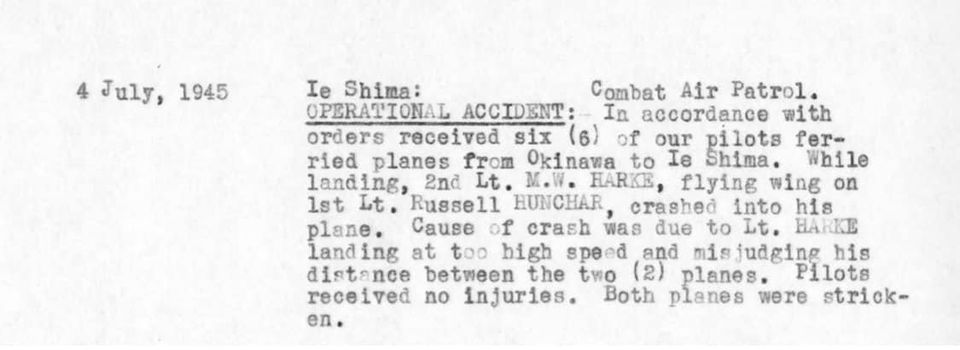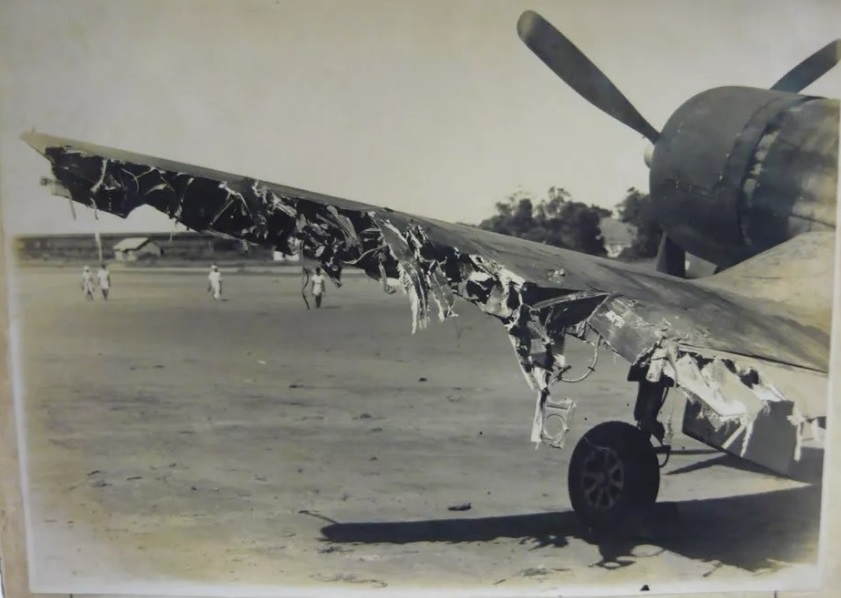|
|
Post by planewriting on Jan 19, 2021 8:21:13 GMT 12
|
|
|
|
Post by davidd on Jan 19, 2021 9:58:57 GMT 12
I would think that this is almost certainly the result of a landing/takeoff or high-speed taxiing collision with another aircraft, or a vehicle, but that is all I would venture. No sign of fire visible to me.
David D
|
|
|
|
Post by tbf2504 on Jan 19, 2021 10:34:45 GMT 12
I would say a ground collision with another taxying aircraft. One clue is the chomping of the fuselage typical of being struck by a rotating propeller blade
|
|
|
|
Post by McFly on Jan 19, 2021 11:19:10 GMT 12
I would say a ground collision with another taxying aircraft. One clue is the chomping of the fuselage typical of being struck by a rotating propeller blade Concur - Comments from another site "This is actually a collision, most likely on the ground. The damage on the spine is a deformation from a wingtip - note how it's parallel to the ground? You see the same pattern on some P-40s that were involved in a collision on December 8, 1941:" See second photo.. 
Damaged F4U-1D Okinawa 1945
 A heavily damaged U.S. Army Air Forces Curtiss P-40 from the 44th Pursuit Squadron at Bellows Field, Territory of Hawaii, after the Japanese attack on 7 December 1941.  |
|
|
|
Post by Dave Homewood on Jan 19, 2021 13:23:20 GMT 12
It is a ground collision. This photo comes up often on Facebook with the purported rubbish story that it happened in the air. Corsair pilot and historian Chris Fahey usually fields it with the actual truth. In one response to a post in October 2020 he wrote: "It was a GROUND COLLISION! Falsely reported in on a book as air to air damage. Nope. The wingman landed too close behind and smacked into his lead. This photo has been posted elsewhere and in different sources but it wasn’t this airplane. Yes, in an air to air fight? The ferry tanks would be gone. And a Corsair won’t fly like that. Here is the original accident report that goes with the photo." And he added this:  |
|
|
|
Post by Dave Homewood on Jan 19, 2021 13:27:57 GMT 12
This one however is genuine air-to-air collision damage. The Corsair of New Zealander Don Cameron, who was in the Royal Navy Fleet Air Arm. This was after a mid-air collision with the Corsair of Petty Officer Dyer, whose aircraft lost a wing and spun in, killing him. Cameron however managed to land safely. Staggering amount of damage sustained and still airworthy.  |
|
|
|
Post by johnnyfalcon on Jan 19, 2021 18:20:12 GMT 12
This one however is genuine air-to-air collision damage. The Corsair of New Zealander Don Cameron, who was in the Royal Navy Fleet Air Arm. This was after a mid-air collision with the Corsair of Petty Officer Dyer, whose aircraft lost a wing and spun in, killing him. Cameron however managed to land safely. Staggering amount of damage sustained and still airworthy.  Great picture and example of the strength of the Corsair for clarification. I'm not sure, if it was me doing the pre-flight walkaround, that I'd consider it "airworthy", but capable of controlled flight makes it impressive ;-) |
|
|
|
Post by Dave Homewood on Jan 19, 2021 18:23:04 GMT 12
Yes I meant airworthy enough to land safely. Not any further.
|
|
|
|
Post by Mustang51 on Jan 20, 2021 10:39:24 GMT 12
That is an almighty amount of damage. I recall (vaguely) an air-to-air pic of an Avenger (I think) heading back to a carrier with incredible damage to one wing
|
|
|
|
Post by McFly on Jan 20, 2021 10:49:34 GMT 12
That is an almighty amount of damage. I recall (vaguely) an air-to-air pic of an Avenger (I think) heading back to a carrier with incredible damage to one wing Something like this...   |
|
|
|
Post by AussieBob on Jan 20, 2021 11:09:49 GMT 12
The background story to that Avenger damage is quite fascinating;
On February 18, 1945, the fast carriers returned to Chichi Jima, 150 miles north of Iwo Jima. Bob King flew an Avenger torpedo bomber off the USS Bennington, with Jimmy Dye and and Grady York as his radioman and gunner. Chichi Jima, with its half-moon bay presented a difficult target for the flyboys and it was their first mission. Only one of them would return.
Chichi Jima's bay was surrounded on three sides by rugged hils. It was a uniquely dangerous place to dive as the antiaircraft fire came not only from below but also from all sides as the planes dove below the level of the hilltops. As the planes pulled out and escaped to the west, Japanese fire would actually come down at them from the caves above.
Bob Cosbie was flying an Avenger to the right of King's bomber, and Jesse Naul was flying behind Cosbie's plane. The three planes were to bomb Chichi Jima's small airstrip. Many years later, Naul would tell James Bradley what happened:
"We came in at about nine thousand feet and we were getting ready to go into our dive. I was behind Cosbie's plane. Suddenly, antiaircraft fire shot Cosbie's right wing off. His plane went into a clockwise spin, spinning clockwise down toward the right, where his wing had been.
"Cosbie's plane flipped upside down and went sideways. It slammed into King's plane. Cosbie's left wing hit King's plane between the turret and the vertical stabilizer. At the same time, Cosbie's propeller hit King's left wing and chewed off four feet of it.
"King's plane then went into a spin. King thought they would crash, so he told his crew to bail out. Jimmy and Grady bailed out. My crew yelled, 'We see two chutes.'
"King had his seat belt off, fixing to bail out, and to his surprise, he got the plane straight. He 'caught it,' meaning he caught the spin and righted the plane. He kept flying."
Cosbie's Avenger continued its violent spin, and the crew couldn't get out. Gunner Lou Gerig and radioman Gil Reynolds went down with their pilot. Naul speculated on what their final minutes might have been like:
"Cosbie went into his spin at nine to ten thousand [feet]. His plane just spun and spun. Let's say they were all alive when the plane went into that spin. Even though they were healthy American males, the centrifugal force would have pinned them to the walls and they wouldn't have been able to get out.
"If they were concious, they knew what was happening and were fighting to get out. They'd be trying to unhook their seat belts and pop the doors off, but they wouldn't have been able to get out of their seats.
"When a loaded seventeen-thousand-pound plane is spinning, it creates a lot of force. It's like a saucer at an amusement park that is spinning and pinning you back. It's the same thing. The force of the spin would force them to remain in the position they were in when they started going down. Finally, they smacked into the water and that was it."
Dye and York parachuted down in the midst of the exploding shells. "Their chutes were surrounded by antiaircraft bursts," recalled Joe Bonn. "I dismissed them as shot up, dead." But the two flyboys were alive, and they landed safely just off shore.
"We flew down to drop them a life raft," Ralph Sengewalt said, "But we didn't drop because we could see Jimmy and Grady in knee-deep water, walking toward the shore. We thought they'd be prisoners and they'd be safe -- at least that was our hope."
Meanwhile, King was nursing his damaged Avenger back to his carrier. He was accompanied by other planes from the squadron. All who saw the torpedo bomber still airborne with most of its left wing missing were amazed. But there was more. The fuselage between the turret and the tail was bent where Cosbie's wing had hit. "Like a playing card bent in half," said Naul. "It was bent in the middle and drooped."
"We told him his landing gear wouldn't work, that he shouldn't even try," Naul said. "We told him he'd have to make a water landing." King ditched his plane near the fleet, and the bomber bent with the impact.
"I tossed King a life raft," said Robert Akerblom. "I opened the door, holding it. 'Now' my pilot yelled."
After his bad jolt, King spent the night in sick bay, but he was alive. He was also a changed man.
"King was the most heartbroken man I ever saw in my life," Sengewalt told Bradley. "He lost two men and lived. He didn't say much. I think he never really recovered from that flight, he was so moved. We knew what he went through; no one blamed him. What he did was almost miraculous."
"All he'd say was, 'I had my seat belt off,'" remembered Naul. "Everybody would have done the same thing. King gave Jimmy and Grady an opportunity to get out. He was looking out for his guys like he was supposed to. He was ready to bail when the plane righted. He was surprised when it did. He had his seat belt off, ready to jump."
Jimmy Dye and Grady York would be one of the eight flyboys captured and killed by the Japanese on Chichi Jima.
Source: Flyboys by James Bradley (Little, Brown: Boston, 2003) pgs. 291-301.
|
|
|
|
Post by Mustang51 on Jan 20, 2021 13:58:39 GMT 12
That's the one.....off the USS Bennington I think. Look at the Starboard aileron deflection. Incredible story.Chichi Jima was the same target that George Bush Snr attacked and was shot down loosing his two crew members. Fortunately he was picked up.
|
|

